Question
Format
- Open ended questions leave room for respondents to answer
how they wish without any suggested answers.
- These questions allow the respondent to formulate their
own answer to the question, which is good if:
- you do not know all the possible answers.
- you want more in-depth responses.
- But can be bad because:
- they can be very hard to code.
- they hurt responses from less talkative people

- Open ended questions should leave enough room to respond,
but not waste space and increase apprehension of a long survey among
respondents.
- Closed questions have set options for the respondent to
choose between.
- These offer much easier coding.
- But care must be taken to formulate good sets of answers.
- With closed questions, the responses must be both exhaustive
and mutually exclusive.
- Exhaustive answers cover all ranges of the potential
spectrum, so that all respondents can answer with one of the choices.
- Mutually exclusive answers allow the respondent to select
only one answer, meaning that if one answer is selected then the
other possible responses are eliminated
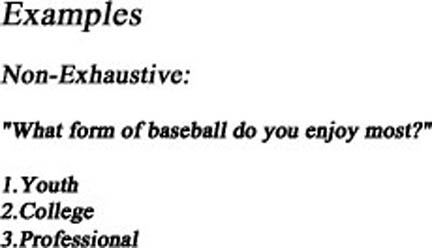
This is non-exhaustive because it does not cover
all possible answers to the question: the respondent could enjoy
playing baseball most.
Better, exhaustive question:

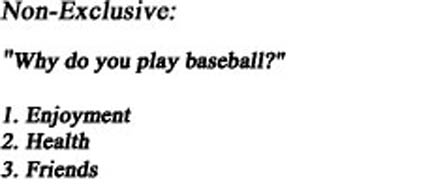
This is non-exclusive because the respondent could play baseball
for all of these reasons.
Better, exclusive question:

- There are many different formats for closed questions that
you can use. Some types of questions lend themselves to a particular
format, however each survey is different and discretion must be used
to simplify the survey as much as possible.
- Likert scales use a range of agreement and disagreement
to measure attitudes and opinions.

- Other similar rating scales can place rankings between
two opposing adjectives (semantic differential), a horizontal scale,
or a vertical ladder. (For more examples click here)
- Likert scale questions are good because you can set them
up in a grid format with only one explanation at the beginning of
the series.
- They can be problematic with longer, more confusing questions.
With those types of questions alternative opinions should be given.

- Scored responses such as this are easy to code because the coding
is already done with the question.
- A problem with this type of question, however, is that in some
cases the responses will have no diversity (ex. if you had the question
"how important are the following things to you: food value,
food taste, etc. then most people will put the "most important"
response.) In this case, ranking responses is a better option.
- Ranking responses allow the respondent to rank items in
relation to each other rather than on an independent scale.

- Ranked responses are good when things need to be compared to each
other rather than taken individually.
- Items must be carefully be listed to avoid biases based on order
of the responses.
- Checklist responses simply give respondents a list of options
from which they can check all that apply.

- Binary choice formats of questions have two responses which
the respondent must decide between.
- Dichotomous questions offer two opposing alternatives.

- Multiple choice formats offer a list of responses from which
the respondent must select one.
- Nominally ranked categories simply have an unranked
list of categories to select from.
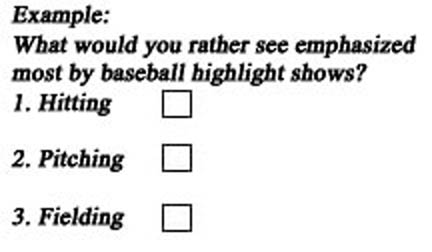
- Ordinally ranked categories will have a list of ranked
responses from high to low.
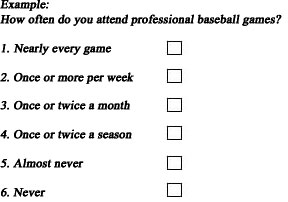
- Ranked attitude statements which offer a range of statements
from which the respondent can choose the closest to their own opinion.
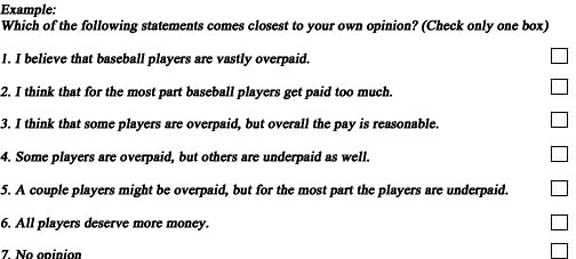
- A final type of multiple choice question either has a
numerical answer or lists numerical ranges.

- The “don’t know” and the “neutral” positions should be offered
in most cases because it avoids forcing people to select an opinion
that they do not have or answering with no knowledge at all.
- Closed questions should be formatted so that they fully
line up and have some box or line to check or a number to circle.
- Contingency questions allow you to get more information
about one particular set of respondents.
- It is important to make it clear that only if the respondent
answered a particular way to an initial question do they proceed to
the next sub-question, and otherwise they should go to a later question.
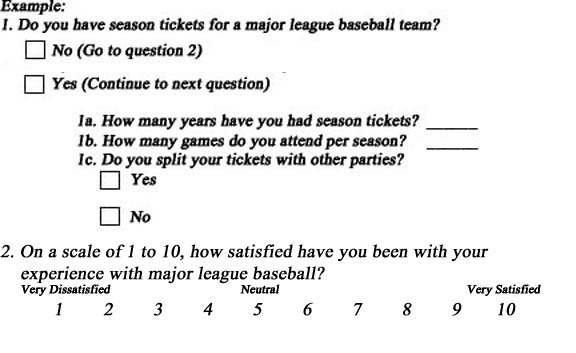

|


